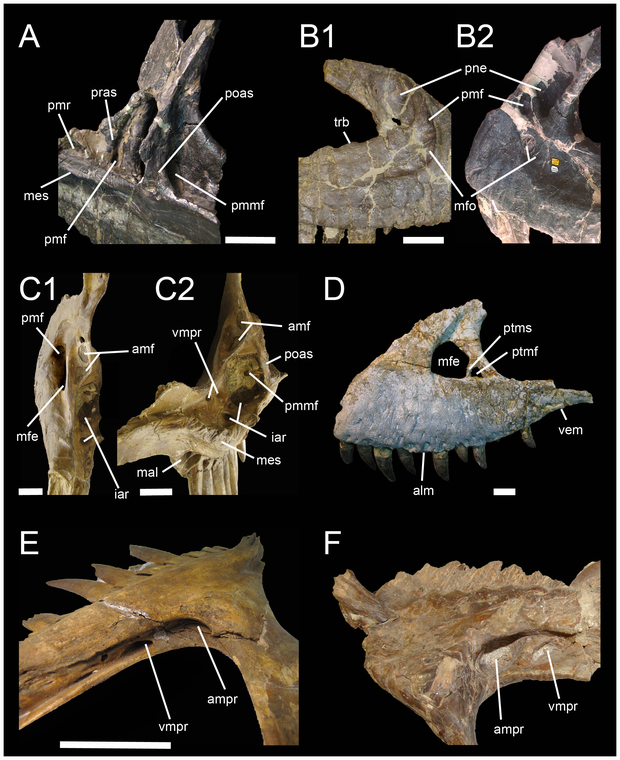A new dinosaur species found in Portugal is one of the largest carnivorous dinosaurs from the Jurassic period - and may be the largest land predator discovered in Europe - 30 feet long and weighing up to 5 tons.
Scientists discovered bones belonging to this dinosaur north of Lisbon. They were originally believed to be Torvosaurus tanneri, a dinosaur species from North America. Closer comparison of the shin bone, upper jawbone, teeth, and partial tail vertebrae suggest to the authors that it may warrant a new species name, Torvosaurus gurneyi.
T. gurneyi had blade-shaped teeth up to 10 cm long, which indicates it may have been at the top of the food chain in the Iberian Peninsula roughly 150 million years ago. The scientists estimate that the dinosaur could reach 10 meters long and weigh around 4 to 5 tons. The number of teeth, as well as size and shape of the mouth, may differentiate the European and the American Torvosaurus.

Proposed terminology and annotation of the nonavian theropod maxilla. A, Right maxilla of Allosaurus fragilis (AMNH 600) in posteromedial view; B, lateral antorbital fossae of Ceratosaurus in lateral view; B1, right maxilla of Ceratosaurus magnicornis (MWC 1) and; B2, left maxilla of Ceratosaurus dentisulcatus (UMNH VP 5278; courtesy of Roger Benson); C, left maxilla of Tyrannosaurus rex (CMNH 9380) in posterodorsal (C1) and dorsal (C2) views; D, left maxilla of Tarbosaurus baatar (ZPAL MgD-I/4; courtesy of Stephen Brusatte) in lateral view; E, right maxilla of Duriavenator hesperis (BMNH R332) in dorsomedial view; and F, left maxilla of Piatnitzkysaurus floresi (PVL 4073) in dorsomedial view (courtesy of Martin Ezcurra). Abbreviations: amf, accessory maxillary fenestra; ammf, anteromedial maxillary fenestra; ampr anteromedial pneumatic recess; iar, interalveolar recess; mal, maxillary alveoli; mes, medial shelf; mfe, maxillary fenestra; mfo, maxillary fossa; pmf, promaxillary fenestra; pmmf, posteromedial maxillary fenestra; pmr, promaxillary recess; pne, pneumatic recess; poas, postantral strut; pras, preantral strut; ptmf, postmaxillary fenestra; ptms, postmaxillary strut; trb, tooth root bulge; vmpr, ventromedial pneumatic recess. Scale bars = 5 cm. Credit:
doi:10.1371/journal.pone.0088905
The fossil of the upper jaw of T. tanneri has 11 or more teeth, while T. gurneyi has fewer than 11. Additionally, the mouth bones have a different shape and structure. The new dinosaur is the second species of Torvosaurus to be named.

Torvosaurus Gurneyi is estimated at up to 10 meters long and 4-5 tons. Credit: Christophe Hendrickx
"This is not the largest predatory dinosaur we know. Tyrannosaurus, Carcharodontosaurus, and Giganotosaurus from the Cretaceous were bigger animals," said Hendrickx. "With a skull of 115 cm, Torvosaurus gurneyi was however one of the largest terrestrial carnivores at this epoch, and an active predator that hunted other large dinosaurs, as evidenced by blade shape teeth up to 10 cm."
Fossil evidences of closely related dinosaurs suggest that this large predator may have already been covered with proto-feathers. Recently described dinosaur embryos from Portugal are also ascribed to the new species of Torvosaurus.






Comments